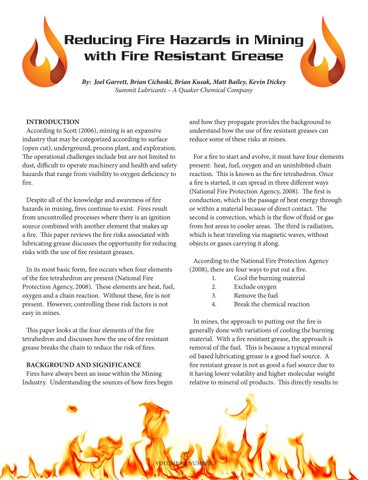Reducing Fire Hazards in Mining with Fire Resistant Grease By: Joel Garrett, Brian Cichoski, Brian Kusak, Matt Bailey, Kevin Dickey Summit Lubricants – A Quaker Chemical Company
INTRODUCTION According to Scott (2006), mining is an expansive industry that may be categorized according to surface (open cut), underground, process plant, and exploration. The operational challenges include but are not limited to dust, difficult to operate machinery and health and safety hazards that range from visibility to oxygen deficiency to fire. Despite all of the knowledge and awareness of fire hazards in mining, fires continue to exist. Fires result from uncontrolled processes where there is an ignition source combined with another element that makes up a fire. This paper reviews the fire risks associated with lubricating grease discusses the opportunity for reducing risks with the use of fire resistant greases. In its most basic form, fire occurs when four elements of the fire tetrahedron are present (National Fire Protection Agency, 2008). These elements are heat, fuel, oxygen and a chain reaction. Without these, fire is not present. However, controlling these risk factors is not easy in mines. This paper looks at the four elements of the fire tetrahedron and discusses how the use of fire resistant grease breaks the chain to reduce the risk of fires. BACKGROUND AND SIGNIFICANCE Fires have always been an issue within the Mining Industry. Understanding the sources of how fires begin
and how they propagate provides the background to understand how the use of fire resistant greases can reduce some of these risks at mines. For a fire to start and evolve, it must have four elements present: heat, fuel, oxygen and an uninhibited chain reaction. This is known as the fire tetrahedron. Once a fire is started, it can spread in three different ways (National Fire Protection Agency, 2008). The first is conduction, which is the passage of heat energy through or within a material because of direct contact. The second is convection, which is the flow of fluid or gas from hot areas to cooler areas. The third is radiation, which is heat traveling via magnetic waves, without objects or gases carrying it along. According to the National Fire Protection Agency (2008), there are four ways to put out a fire. 1. Cool the burning material 2. Exclude oxygen 3. Remove the fuel 4. Break the chemical reaction In mines, the approach to putting out the fire is generally done with variations of cooling the burning material. With a fire resistant grease, the approach is removal of the fuel. This is because a typical mineral oil based lubricating grease is a good fuel source. A fire resistant grease is not as good a fuel source due to it having lower volatility and higher molecular weight relative to mineral oil products. This directly results in
- 34 VOLUME 80, NUMBER 3









